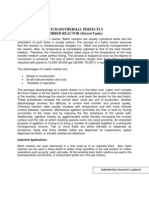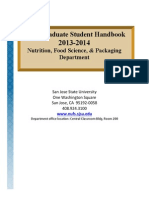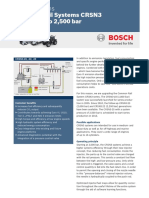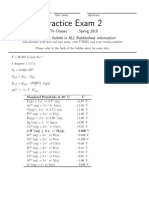Reactors1 29
Reactors1 29
Uploaded by
Mourad kharbachCopyright:
Available Formats
Reactors1 29
Reactors1 29
Uploaded by
Mourad kharbachOriginal Description:
Original Title
Copyright
Available Formats
Share this document
Did you find this document useful?
Is this content inappropriate?
Copyright:
Available Formats
Reactors1 29
Reactors1 29
Uploaded by
Mourad kharbachCopyright:
Available Formats
However, many of the stirred-tank reactors have benefits of the tubular flow
reactors. These include isolation of intermediates, automatic control, and low
labor costs .
2. Heat Effects
Most reactors used in industrial operations run isothermally. For adiabatic
operation, principles of thermodynamics are combined with reactor design
equations to predict conversion with changing temperature. Rates of reaction
normally increase with temperature, but chemical equilibrium must be checked to
determine ultimate levels of conversion. The search for an optimum isothermal
temperature is common for series or parallel reactions, since the rate constants
change differently for each reaction. Special operating conditions must be
considered for any highly endothermic or exothermic reaction.
3. Design for Multiple Reactors
Common design problems encountered in industrial operations include size
comparisons for single reactors, multiple reactor systems, and recycle reactors.
a. Size Comparisons of Single Isothermal Flow Reactors. The rate of
reaction of a CSTR is always fixed by the outlet concentrations. Since the rate is
constant (first- or second-order, etc.), a large volume is required to provide
enough time for high conversion. In general, a plug flow reactor is much more
efficient and requires less volume than a stirred-tank reactor to achieve the same
level of conversion. In a plug flow reactor, the rate changes down the length of
the reactor due to changes in reactant concentrations. High initial rates prevail in
the front of the reactor with decreasing rates near the end. The overall integration
of these rates is much higher than the fixed rate in a CSTR of equal volume. For
complex kinetics such as autocatalytic reactions, where the concentrations of both
reactants and products increase the forward rate of reaction, stirred-tank reactors
are preferred and require less volume. Under most common kinetics, a series of
three or four stirred-tank reactors of equal volume in series approaches the
performance of a plug flow reactor.
b. Reactors in Series and Parallel.
i. PLUG FLOW REACTORS. Plug flow reactors are unique in the sense that
operation in parallel or series give the same conversion if the space time is held
constant. This implies, for example, that if a 20-m reactor of fixed diameter is
required to achieve a given conversion, the same conversion and capacity can be
achieved by running ten 2-m reactors in series or ten 2-m reactors in parallel. The
split of the feed in the parallel case must be one tenth of the total to keep the same
space time. In industrial applications the geometry chosen is a function of cost of
construction, ease of operation, and pressure drop. Parallel operation is normally
preferred to keep the pressure drop at a minimum.
ii. STIRRED-TANK REACTORS IN SERIES AND PARALLEL. Stirred-tank
reactors behave somewhat differently from plug flow reactors. Operation of
CSTRs in parallel, assuming equal space time per reactor, gives the same
conversion as a single reactor but increases the throughput or capacity
proportional to the number of reactors.
This is not the case for multiple CSTRs in series. CSTRs operated in series
approach plug flow and therefore give much higher levels of throughput for the
same conversion. When we have two reactors of unequal size in series, highest
conversion is achieved by keeping the intermediate concentration as high as
possible. This implies putting the small CSTR before the large CSTR.
c. Plug Flow and Stirred Tank Reactors in Series. When two reactors, a plug
flow and a stirred tank are operated in series, which one should go first for
maximum conversion? To solve this problem the intermediate conversion is
calculated, the outlet conversions are determined, and the best arrangement
chosen. Keeping the intermediate conversion as high as possible results in the
maximum conversion. Concentration levels in the feed do not affect the results of
this analysis as long as we have equal molar feed.
4. Recycle Reactors
In a recycle reactor, part of the exit stream is recycled back to the inlet of the
reactor. For a stirred-tank reactor, recycle has no effect on conversion, since we
are essentially just mixing a mixed reactor. For a plug flow reactor, the effect of
recycle is to approach the performance of a CSTR. This is advantageous for
certain applications such as autocatalytic reactions and multiple reaction
situations where we have a PFR but really require a CSTR.
IV. Special Reactor Configurations
Additional reactors exist that are either completely or partially based on the five
primary reactor types discussed in Section II. They receive special attention due
to specific applications and/or unique mass transfer characteristics.
A. AUTOCLAVE
DESCRIPTION. The autoclave reactor is a small cylindrical reactor, built to
withstand high pressures, used to evaluate the kinetics of hightemperature, high-
pressure reactions and the production of small quantities of specialty chemicals.
The reactor is typically packed with a supported catalyst, and reactant is added by
injection. Pressure in the system is elevated by increasing the temperature of the
autoclave. Additional pressure, if needed, can be obtained with the injection of
additional gaseous reactant or an inert.
CLASSIFICATION. The autoclave is usually a heterogeneous batch reactor
mainly used for high-pressure kinetic studies. The autoclave is typically a solid
catalyzed gas-liquid reaction system.
You might also like
- Types of ReactorsDocument8 pagesTypes of ReactorsAli Ahmad94% (17)
- TDS Mada Access Panel 1Document1 pageTDS Mada Access Panel 1markNo ratings yet
- Study of a reluctance magnetic gearbox for energy storage system applicationFrom EverandStudy of a reluctance magnetic gearbox for energy storage system applicationRating: 1 out of 5 stars1/5 (1)
- Background Study On Continuously Stirred Tank ReactorDocument4 pagesBackground Study On Continuously Stirred Tank ReactorSyazani HussainiNo ratings yet
- Stirred Tank Reactors in SeriesDocument25 pagesStirred Tank Reactors in SeriesChristopher Emeka Ominyi50% (2)
- Advantages and Disadvantages of A CSTRDocument3 pagesAdvantages and Disadvantages of A CSTRszulkipeli50% (8)
- Procedure For Lifting Operations Over Live Process Are AsDocument11 pagesProcedure For Lifting Operations Over Live Process Are Aszam110No ratings yet
- Edited Ela PPT PRSNDocument82 pagesEdited Ela PPT PRSNWin TerNo ratings yet
- Continuous Stirred Tank ReactorDocument11 pagesContinuous Stirred Tank ReactorFikrie Muhd50% (2)
- Reactors1 5Document5 pagesReactors1 5Mourad kharbachNo ratings yet
- Chemical ReactorDocument15 pagesChemical ReactorMithelesh KoulNo ratings yet
- Chemical ReactorDocument5 pagesChemical Reactornevelle4667No ratings yet
- ReactorsDocument7 pagesReactorsLyka BalmesNo ratings yet
- Design For A High Temperature Shift ConverterDocument43 pagesDesign For A High Temperature Shift ConverterAaron GyamfiNo ratings yet
- Chemical Reactor2Document5 pagesChemical Reactor2Sohail AsgharNo ratings yet
- CSTRDocument27 pagesCSTRLeslie AmadorNo ratings yet
- F5C1 1917Document11 pagesF5C1 1917muhammad umairNo ratings yet
- Prowess T Ngwenya SMA 2116 ProjectDocument11 pagesProwess T Ngwenya SMA 2116 ProjectProwess NgwenyaNo ratings yet
- Types of Reactor2Document4 pagesTypes of Reactor2Aleem AhmedNo ratings yet
- Cinética Química UDocument16 pagesCinética Química UJesus Manuel Yallerco VenegasNo ratings yet
- Tutorial Exp 4Document4 pagesTutorial Exp 4Faris Hamir100% (4)
- Unit 5Document16 pagesUnit 5Sakthivel PandianNo ratings yet
- Mole Balances: Industrial ReactorsDocument3 pagesMole Balances: Industrial Reactorsdina rodianaNo ratings yet
- Reactor Selection: Cross-Sectional Diagram of Continuous Flow Stirred-Tank ReactorDocument2 pagesReactor Selection: Cross-Sectional Diagram of Continuous Flow Stirred-Tank ReactorNorzul AfifuddinNo ratings yet
- Reactors1 35Document2 pagesReactors1 35Mourad kharbachNo ratings yet
- R SDocument6 pagesR S0a1l2i3.h4a5s6s7a8n9No ratings yet
- New DacumentsDocument13 pagesNew DacumentsMustafa Khan100% (1)
- Types of ReactorsDocument16 pagesTypes of Reactorsmunding21No ratings yet
- Reactors1 9Document4 pagesReactors1 9Mourad kharbachNo ratings yet
- Advantages and Disadvantages of A CSTRDocument3 pagesAdvantages and Disadvantages of A CSTRGwee Yongkuan50% (2)
- Choice of reactorsDocument2 pagesChoice of reactorsKetul ShahNo ratings yet
- Choice of Reactors For Chemical ReactionsDocument4 pagesChoice of Reactors For Chemical ReactionsMegh JoshiNo ratings yet
- Reactor of Chemical Engineering: Presented by Nazarudin, PHDDocument69 pagesReactor of Chemical Engineering: Presented by Nazarudin, PHDAsmi RamadhaniNo ratings yet
- Lecture 16 - BT209 - 16022022Document9 pagesLecture 16 - BT209 - 16022022Sneha SinghNo ratings yet
- Continuous Stirred Tank Reactor (CSTR)Document1 pageContinuous Stirred Tank Reactor (CSTR)ShieeplNo ratings yet
- Exp 1 CPPDocument3 pagesExp 1 CPPAzwa FamiezaNo ratings yet
- Reactors1 2Document4 pagesReactors1 2Mourad kharbachNo ratings yet
- CSTR 40lDocument22 pagesCSTR 40lafnan_lion94No ratings yet
- CSTR DanielDocument37 pagesCSTR DanielKENNETHNo ratings yet
- Cpo ReportDocument20 pagesCpo ReportSyeda Khaliqa HamidNo ratings yet
- High Performance Gas-Liquid Reaction Technology: HH Technology Corp., Sissach, SwitzerlandDocument15 pagesHigh Performance Gas-Liquid Reaction Technology: HH Technology Corp., Sissach, SwitzerlandzackNo ratings yet
- Types of ReactorsDocument5 pagesTypes of ReactorsPl ElectricalNo ratings yet
- Cstr-Experiment 2Document7 pagesCstr-Experiment 2Dhiyyah MardhiyyahNo ratings yet
- BNBBHBHBHJBJHDocument25 pagesBNBBHBHBHJBJHZati TarhiziNo ratings yet
- Differential ReactorDocument3 pagesDifferential ReactorCik Tiem Ngagiman100% (1)
- BCT Loop Reactor Technology 2009-02-2Document7 pagesBCT Loop Reactor Technology 2009-02-2fsingNo ratings yet
- TutoDocument2 pagesTutoFfmohamad NAd0% (1)
- CSTR in SeriesDocument12 pagesCSTR in Seriesmnizamarzuki0% (2)
- Differential Reactor. We Have A Differential Flow Reactor When We Choose ToDocument8 pagesDifferential Reactor. We Have A Differential Flow Reactor When We Choose ToIloan ManaluNo ratings yet
- VallesBrullJudit MastersThesis 3Document70 pagesVallesBrullJudit MastersThesis 3salim salimNo ratings yet
- Chemical Reactor Selection and DesignDocument36 pagesChemical Reactor Selection and Designrajadcet12100% (4)
- PCE321 - Ch04Document30 pagesPCE321 - Ch04Osama RamadanNo ratings yet
- Project Report NewDocument41 pagesProject Report Newrohith reddyNo ratings yet
- Stirred Tank ReactorDocument32 pagesStirred Tank ReactorChristopher Emeka Ominyi100% (1)
- UntitledDocument15 pagesUntitledKELEBOGILE LEAGO MAKGAHLELANo ratings yet
- Hysys Project of Chemical Reaction Engineering: Prepared By: Mahmoud Mohamed ID: 141761Document9 pagesHysys Project of Chemical Reaction Engineering: Prepared By: Mahmoud Mohamed ID: 141761Mahmoud HendawyNo ratings yet
- Question 19 What Considerations Do You Use For Designing A Hydrocracking Reactor What Criteria Do You Use To Determine Number of Beds Diameter and Beds LengthsDocument6 pagesQuestion 19 What Considerations Do You Use For Designing A Hydrocracking Reactor What Criteria Do You Use To Determine Number of Beds Diameter and Beds LengthsThế vũ Đặng vănNo ratings yet
- Assignment Reactor 1Document14 pagesAssignment Reactor 1DilaFirizqinaNo ratings yet
- Dynamics and Control of Recycle Systems. 2. Comparison Alternative Process DesignsDocument11 pagesDynamics and Control of Recycle Systems. 2. Comparison Alternative Process DesignsJean Pierre León BravoNo ratings yet
- Report On Reactor Isomerization of Light Naphtha: Prepared byDocument8 pagesReport On Reactor Isomerization of Light Naphtha: Prepared byاحمد حمید کارسول عزیزNo ratings yet
- Reaction Technologies: ThreeDocument31 pagesReaction Technologies: ThreeProcess EngineerNo ratings yet
- Reactors1 27Document2 pagesReactors1 27Mourad kharbachNo ratings yet
- Reactors1 23Document2 pagesReactors1 23Mourad kharbachNo ratings yet
- Reactors1 16Document3 pagesReactors1 16Mourad kharbachNo ratings yet
- Kinetics 2Document1 pageKinetics 2Mourad kharbachNo ratings yet
- Reactors1 2Document4 pagesReactors1 2Mourad kharbachNo ratings yet
- Ugradreshndbk PDFDocument50 pagesUgradreshndbk PDFSaepul Adnand AfgandiNo ratings yet
- DD4450 Service ManualDocument240 pagesDD4450 Service ManualServnetTechnicianNo ratings yet
- Case Study 101Document9 pagesCase Study 101AtlantislandNo ratings yet
- IU Car Rental SummaryDocument2 pagesIU Car Rental SummaryMurat GülerNo ratings yet
- Q4 HE Nail Care 9 Week 6Document3 pagesQ4 HE Nail Care 9 Week 6krinessa erika m. de chavezNo ratings yet
- Material Case Study: Building Services Iv-Game Centre DesignDocument45 pagesMaterial Case Study: Building Services Iv-Game Centre DesignSharvani MedaNo ratings yet
- Chemical Oxygen Demand in Waste WaterDocument3 pagesChemical Oxygen Demand in Waste WaterGopal MallickNo ratings yet
- Pathogenesis of Infectious Coryza in Chickens (Gallus Gallus) by AvibacteriumDocument8 pagesPathogenesis of Infectious Coryza in Chickens (Gallus Gallus) by AvibacteriumNoman FarookNo ratings yet
- The Endocrine System Trans PDFDocument12 pagesThe Endocrine System Trans PDFRegina CantileroNo ratings yet
- Understanding Drug Abuse and Addiction What Science Says PDFDocument32 pagesUnderstanding Drug Abuse and Addiction What Science Says PDFAljen CastilloNo ratings yet
- 8096CRSN3 25 - Factsheet e PDFDocument2 pages8096CRSN3 25 - Factsheet e PDFLuis MirandaNo ratings yet
- Caribou-Munroes Island Provincial Park: 2119 Three Brooks Road, Caribou, NS - 902-485-6134Document1 pageCaribou-Munroes Island Provincial Park: 2119 Three Brooks Road, Caribou, NS - 902-485-6134mishka123No ratings yet
- CAR T Therapy Beyond Cancer: The Evolution of A Living Drug: PerspectiveDocument9 pagesCAR T Therapy Beyond Cancer: The Evolution of A Living Drug: PerspectiveCinta DíezNo ratings yet
- Schramm Chain AdjustmentDocument4 pagesSchramm Chain AdjustmentRafaelNo ratings yet
- Employee Stock Option SchemeDocument6 pagesEmployee Stock Option Schemezenith chhablaniNo ratings yet
- Icing TestDocument9 pagesIcing TestP. PintsNo ratings yet
- Tool Box TalkDocument7 pagesTool Box TalkSantosh Kumar MohantyNo ratings yet
- What Are Eating Disorders?Document1 pageWhat Are Eating Disorders?Wendy CastilloNo ratings yet
- Guide To ChakrasDocument27 pagesGuide To Chakrasseeker33100% (5)
- Cooler PDFDocument6 pagesCooler PDFAliRashidNo ratings yet
- Energy Storage SystemDocument12 pagesEnergy Storage SystemLeeNo ratings yet
- 001 Practice Exam 2: TTH Classes Spring 2016 Remember: Bubble in All Bubblesheet Information!Document9 pages001 Practice Exam 2: TTH Classes Spring 2016 Remember: Bubble in All Bubblesheet Information!meseret simachewNo ratings yet
- English Vocabulary List MadeDocument14 pagesEnglish Vocabulary List MadeRolNo ratings yet
- Hospitals Emails PKDocument4 pagesHospitals Emails PKEngr Hamid AliNo ratings yet
- 2019 - Pathways To Green India - Ways To Protect Our Species EbookDocument62 pages2019 - Pathways To Green India - Ways To Protect Our Species Ebookearthday100% (3)
- 2009.03 Salmonella en Alimentos y Superficies - GDSDocument4 pages2009.03 Salmonella en Alimentos y Superficies - GDSJavier muñozNo ratings yet
- The Olympus SpecificationDocument1 pageThe Olympus SpecificationAmey KadamNo ratings yet





























































































